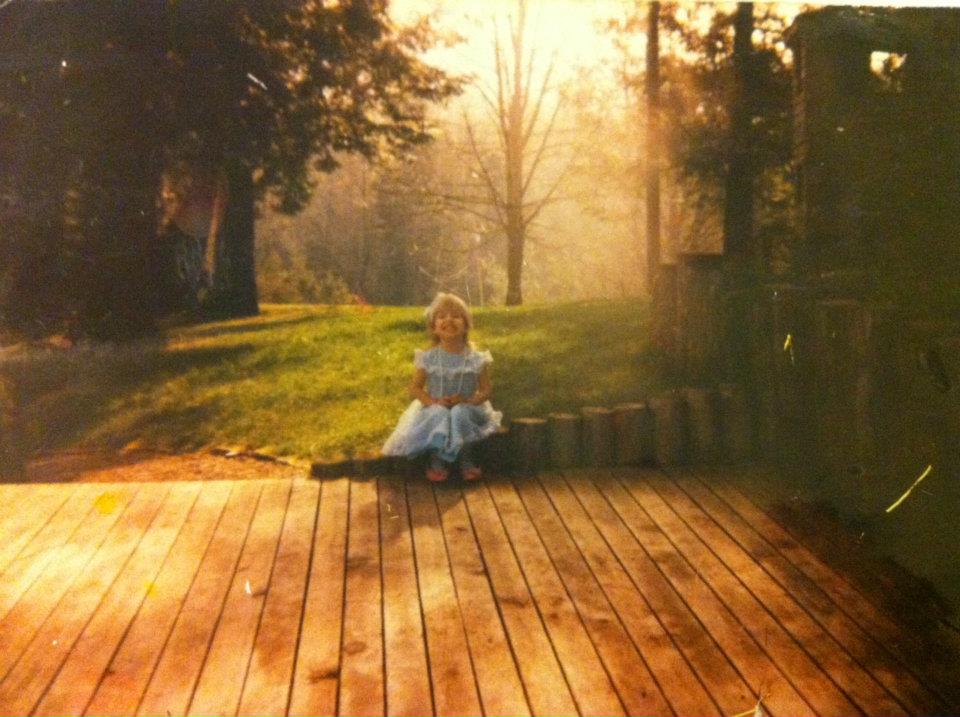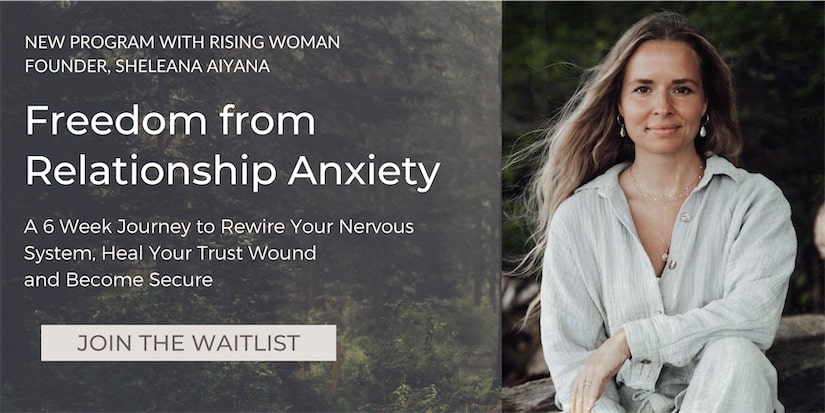Everything feels more intense with an abandonment wound.
We might find ourselves being “the anxious one” in the relationship, or attracting partners who are avoidant (or they might seem avoidant to us because any space they take during conflict or otherwise feels like abandonment.)
Learning to self-soothe when we’re triggered can help us come home to our bodies when we’re overwhelmed with emotion.
It can also help us shift any anxious-avoidant, push-pull patterns that may be going on in our intimate relationship as well as overcome any addictions or “numbing techniques” we may resort to when we’re really upset.
Things like drinking alcohol, smoking cannabis, having sex, binge-eating, shopping or watching Netflix are some of the ways we numb out. (None of these things are inherently “bad” but like anything, we can overdo it as a means of escape.)
When we have an abandonment wound, we may perceive minor upsets as a more significant threat and struggle to maintain our center in the midst of conflict.
Even if the threat isn’t real, these moments can feel terrifying and trigger a deep fear of abandonment and loss.
We may feel like we need someone to save us from our big emotions. We might feel as though the walls are caving in on us; we might over-react, or make demands of our partner from a place of urgency or fear.
We might panic if our partner needs space, or assume that conflict means the relationship is over. We might feel an overwhelming urge to fix the problem now and become bitter and resentful if our partner isn’t ready.
If this happens to you, you are not broken. You are not crazy. You have an abandonment wound and an inner-child that needs tending to.

Your inner child is the “little you.” The innocent, vulnerable, irrational little you that has feelings that don’t make sense and may not always know how to express them.
As an adult, it’s now your job to tend to the “little you,” your inner-child, and learn to self-soothe in moments of heightened emotion, stress or fear. Anxious and Avoidant patterns in a relationship usually look like one person who’s overextending themselves (moving towards, applying pressure, making demands), and one person who’s under-extending (moving away, shutting down, under-communicative).
If you’re the anxious one in the equation, you might think it’s the avoidant person throwing a wrench in the wheel. But consider this: what if their avoidance is a gift to you. An invitation for you to slow down, be present with yourself in the midst of having BIG emotions, and learn how to feel your way through without grasping externally.
As long as you’re focused on the other person and what they need to do for you to be ok, the pattern cannot shift. Patterns break when we look at the situation with a fresh perspective and change not only our behavior but our internal dialogue about the problem. As long as we believe the problem is outside of us, the pattern will find a way to emerge over and over again, even if you have a secure partner.
Our responsibility as the anxious person in this dynamic is to learn how to hold space for ourselves and take the pressure off of the other person. The reality is, even if your avoidant partner did show up for you in the exact way you desire, you might feel better at that moment but your wound would still be alive. Self-soothing is about learning how to calm your nervous system down and be there for yourself when you feel scared.
In essence, you are mothering your inner-child; nurturing that little one inside of you who needs attention, wants to feel safe, seen, heard and loved. We can find people to fill that space for us temporarily, but at the end of the day, there is nothing more healing than learning that we can hold space for ourselves.
How I Learned to Self-Soothe When In Conflict with My Partner
When Ben and I entered our own “power struggle phase” and began to have conflict, we realized we were playing out old patterns.
I played an anxious role, and he played the avoidant role. I would lean in and apply pressure. “Let’s fix this problem now!” He would take space, sometimes even an entire day without communication. If you’re an anxious type, I don’t need to tell you how long a day feels when there’s disharmony in the relationship.
For a while, I looked at the issue as a “him” problem. His avoidance was clearly in the way of us being able to relate consciously, and for the pattern to shift, he was the one who needed to lean in. My blind spot was the fact that he couldn’t possibly lean in when I was energetically launching at him every time we had a conflict… (oopsie)
Both of us have been engaged in Conscious Relationship work and group therapy together since the inception of our partnership, so we would sit down and have clearings about our conflict style and deploy plans to “break the pattern.” We shared what each of us represented to one another during a conflict and softened to one another along the way.
I explained that when he shut down or took space from me after a fight I felt like an abandoned three-year-old again. He shared that he felt overwhelmed by my big emotions because he grew up in a home with an overbearing and dominant brother who always took up a lot of energy.
This helped us both understand our behavior and have compassion for each other and ourselves. As I was able to see his avoidance for what it was (fear, overwhelm, stress), I was able to be in my heart with him more and stop taking his behavior personally. As he learned more about me, he was able to see my scared, sensitive inner child seeking love and acceptance. We put photos of ourselves as little kids up on our fridge as a little reminder of who we’re dealing with in those trying times.
He let me know that when he was taking space, he was never thinking of leaving the relationship and that he would always come back. Ben revealing this to me showed me that he was more or less secure in the relationship, and to him, taking space was just a necessary self-care piece. But due to my own anxiety, I had turned the whole thing in my mind into a very big deal. Thus, it became one! We really struggled with this for while.
Then one day, when conflict arose, and he started to shut-down, I chose a different path. This time, I asked him once to hold space for me, and when he said he couldn’t, I let him know that I was going to go into the other room and move some energy.
I wrapped myself up in a blanket and placed my hands on my heart and womb. I cried, thrashed and felt into the pain and fear of abandonment welling up inside of me. I spoke to my inner-child and let her know she was safe and loved. I grieved the lack of emotional support I had as a child and began to rebuild a relationship with my “little girl” as a mature, adult woman who could now do something different.
As I started to take care of my own emotional needs and create space for Ben in times of conflict, I noticed something shifting. Rather than shutting down, he began moving toward me.
I felt calmer because I no longer needed something from him, and he felt freer because he was no longer on the hook to be different or show up on my terms.
This was when the pattern began to shift. It took us about 1.5 years to get to a place where we can now move through conflict in just a few minutes (most of the time), and we rarely spend much time “fighting.” But the pattern didn’t shift because I was able to convince him that his behavior was a problem, nor because he decided to jump in and save the day whenever I was having a tough time.
The pattern shifted because we both learned to develop compassion for each other in times of conflict. We chose to deepen our self-awareness and let go of our position a little bit faster each time. Slowly, we developed the maturity in our relationship to drop our projections and stop responding to one another from our wounds. In essence, I no longer indulged the “poor me, you are abandoning me” tendencies, and he no longer indulged the “I don’t want to feel, you’re too much for me” tendency.
As I grew in my capacity to self-soothe, Ben grew in his own capacity to hold space. That’s a whole other topic that will be covered soon, but for now, you can listen to his podcast on holding space that he did with our friend Mark Groves.
We talk a lot about Conscious Relationship on Ben’s Evolving Man Podcast, here are our two latest episodes:
Healing through Conscious Relationship

Inner-Child Work & Self Soothing Practice:
- When you’re feeling triggered, take a few deep breaths and close your eyes.
- Place your hands on your heart and root space, and breathe deeply.
- Now visualize your inner-child (the little you at say three years old) and tell them they’re safe.
- Remind yourself that big emotions are ok and that it’s safe to feel.
- You can move some of the energy by crying, thrashing and screaming into pillows. When the energy begins to shift, move into a more meditative space, eyes closed, hands still on your heart and root center, allow whatever comes up and be still with yourself.
- Simply observe any thoughts or emotions as they arise, and then let them go. (Tip for the visual folks: you visualize your thoughts/emotions floating from your body, out through the top of your head.)
- Keep breathing, and remember, this is a healthy expression of your emotion even if it feels messy and chaotic.
Notes: As you do this practice, you’re learning to take responsibility for your energy and training yourself to learn how to self-soothe in moments of stress. As you begin to feel safer in your own emotions, you may find yourself less drawn to your old numbing behaviors.
And, if you’re in a relationship, you’re also giving your partner the space to come towards you. Remember, if we are aggressively or anxiously moving towards someone, their most primal response is to move away. If we want the pattern to shift, we must change our behavior and our internal dialogue.
Take all of that energy you could spend focusing on external forces or people you can’t control and bring it home. Healing takes time, so be gentle with yourself. This is one of the most empowering practices someone with an abandonment wound can ever learn.


